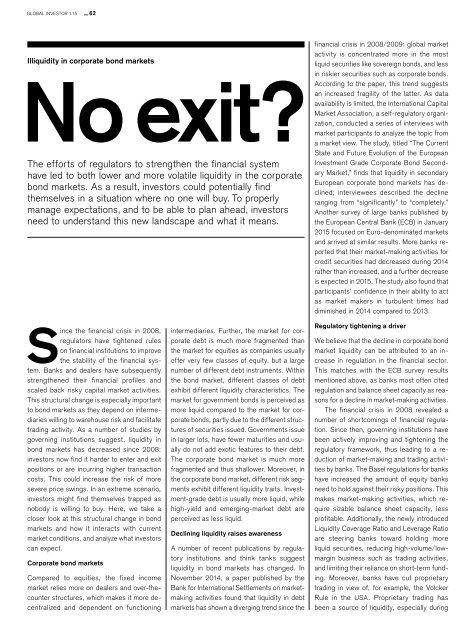Illiquid assets
Unwrapping alternative returns Global Investor, 01/2015 Credit Suisse
Unwrapping alternative returns
Global Investor, 01/2015
Credit Suisse
Create successful ePaper yourself
Turn your PDF publications into a flip-book with our unique Google optimized e-Paper software.
GLOBAL INVESTOR 1.15 — 62<br />
<strong>Illiquid</strong>ity in corporate bond markets<br />
No exit?<br />
The efforts of regulators to strengthen the financial system<br />
have led to both lower and more volatile liquidity in the corporate<br />
bond markets. As a result, investors could potentially find<br />
themselves in a situation where no one will buy. To properly<br />
manage expectations, and to be able to plan ahead, investors<br />
need to understand this new landscape and what it means.<br />
financial crisis in 2008/2009: global market<br />
activity is concentrated more in the most<br />
liquid securities like sovereign bonds, and less<br />
in riskier securities such as corporate bonds.<br />
According to the paper, this trend suggests<br />
an increased fragility of the latter. As data<br />
availability is limited, the International Capital<br />
Market Association, a self-regulatory organization,<br />
conducted a series of interviews with<br />
market participants to analyze the topic from<br />
a market view. The study, titled “The Current<br />
State and Future Evolution of the European<br />
Investment Grade Corporate Bond Secondary<br />
Market,” finds that liquidity in secondary<br />
European corporate bond markets has declined;<br />
interviewees described the decline<br />
ranging from “significantly” to “completely.”<br />
Another survey of large banks published by<br />
the European Central Bank (ECB) in January<br />
2015 focused on Euro-denominated markets<br />
and arrived at similar results. More banks reported<br />
that their market-making activities for<br />
credit securities had decreased during 2014<br />
rather than increased, and a further decrease<br />
is expected in 2015. The study also found that<br />
participants’ confidence in their ability to act<br />
as market makers in turbulent times had<br />
diminished in 2014 compared to 2013.<br />
Since the financial crisis in 2008,<br />
regulators have tightened rules<br />
on financial institutions to improve<br />
the stability of the financial system.<br />
Banks and dealers have subsequently<br />
strengthened their financial profiles and<br />
scaled back risky capital market activities.<br />
This structural change is especially important<br />
to bond markets as they depend on intermediaries<br />
willing to warehouse risk and facilitate<br />
trading activity. As a number of studies by<br />
governing institutions suggest, liquidity in<br />
bond markets has decreased since 2008:<br />
investors now find it harder to enter and exit<br />
positions or are incurring higher transaction<br />
costs. This could increase the risk of more<br />
severe price swings. In an extreme scenario,<br />
investors might find themselves trapped as<br />
nobody is willing to buy. Here, we take a<br />
closer look at this structural change in bond<br />
markets and how it interacts with current<br />
market conditions, and analyze what investors<br />
can expect.<br />
Corporate bond markets<br />
Compared to equities, the fixed income<br />
market relies more on dealers and over-thecounter<br />
structures, which makes it more decentralized<br />
and dependent on functioning<br />
intermediaries. Further, the market for corporate<br />
debt is much more fragmented than<br />
the market for equities as companies usually<br />
offer very few classes of equity, but a large<br />
number of different debt instruments. Within<br />
the bond market, different classes of debt<br />
exhibit different liquidity characteristics. The<br />
market for government bonds is perceived as<br />
more liquid compared to the market for corporate<br />
bonds, partly due to the different structures<br />
of securities issued. Governments issue<br />
in larger lots, have fewer maturities and usually<br />
do not add exotic features to their debt.<br />
The corporate bond market is much more<br />
fragmented and thus shallower. Moreover, in<br />
the corporate bond market, different risk segments<br />
exhibit different liquidity traits. Investment-grade<br />
debt is usually more liquid, while<br />
high-yield and emerging-market debt are<br />
perceived as less liquid.<br />
Declining liquidity raises awareness<br />
A number of recent publications by regulatory<br />
institutions and think tanks suggest<br />
liquidity in bond markets has changed. In<br />
November 2014, a paper published by the<br />
Bank for International Settlements on marketmaking<br />
activities found that liquidity in debt<br />
markets has shown a diverging trend since the<br />
Regulatory tightening a driver<br />
We believe that the decline in corporate bond<br />
market liquidity can be attributed to an increase<br />
in regulation in the financial sector.<br />
This matches with the ECB survey results<br />
mentioned above, as banks most often cited<br />
regulation and balance sheet capacity as reasons<br />
for a decline in market-making activities.<br />
The financial crisis in 2008 revealed a<br />
number of shortcomings of financial regulation.<br />
Since then, governing institutions have<br />
been actively improving and tightening the<br />
regulatory framework, thus leading to a reduction<br />
of market-making and trading activities<br />
by banks. The Basel regulations for banks<br />
have increased the amount of equity banks<br />
need to hold against their risky positions. This<br />
makes market-making activities, which require<br />
sizable balance sheet capacity, less<br />
profitable. Additionally, the newly introduced<br />
Liquidity Coverage Ratio and Leverage Ratio<br />
are steering banks toward holding more<br />
liquid securities, reducing high-volume/lowmargin<br />
business such as trading activities,<br />
and limiting their reliance on short-term funding.<br />
Moreover, banks have cut proprietary<br />
trading in view of, for example, the Volcker<br />
Rule in the USA. Proprietary trading has<br />
been a source of liquidity, especially during

















